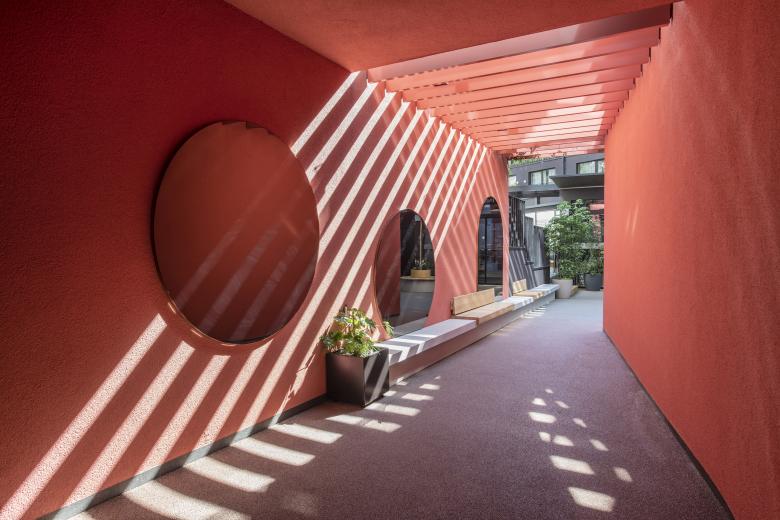Hotel Indigo
Vienna, Austria
Urban Jungle.
BWM Architekten were tasked with designing the façade and the interior of British boutique hotel chain IHG’s first hotel in Austria and have created a magical garden oasis in Vienna’s Margareten district.
The magic of Pawlatschen
Guests enter through an understated entrance inserted in a striking façade (concept by BWM Architekten and TM Architektur ZT GmbH) and then pass through a narrow corridor into a secluded inner courtyard that provides respite from the hustle and bustle of the city. The eye is immediately drawn to the outdoor access galleries (known as Pawlatschen) running all around the courtyard; these are typical for the 5th district and for Vienna in general.
“The hotel is a new build – that’s something we didn’t want to disguise,” says Erich Bernard. “But we did want to consolidate it with its historical surroundings and create a clear connection with Vienna.”
In addition to the access galleries inspired by traditional Viennese Pawlatschen, there are also other elements, materials and colours that typify the city and, specifically, the district along Wien River and the famous Naschmarkt. These include the so-called Viennese tile parquet, which consists of tiles laid out in a pattern with a trim edge, a technique often found in traditional Viennese entrance halls and in the underground stations designed by architect Otto Wagner in the early 1900s. Two other typical elements in the interior design are Viennese wickerwork, as used for the hanging lamps, and the herringbone parquet in the library.
Magic garden
After entering through the corridor, guests find themselves in the courtyard full of greenery, lined with access galleries adorned with hanging plants. “The courtyard is a magical secret garden, a green oasis in the middle of the city,” Erich Bernard explains.
The garden concept also extends into the hotel’s verdant interior. Part of the lobby is a conservatory where expansive windows (which can be opened in the warm months of the year) are the only thing separating it from the outside. Different floor materials and carpets help to define the various zones and moods. The dark-stained oak parquet floor in the library, for instance, creates a cosy atmosphere, while the red terrazzo floor made from fine stoneware sets the bar area apart.
Restaurant with green courtyard
The 438m2 restaurant on the ground floor has seating for 197 guests, and its large windows offer an uninterrupted view of the greenery in the courtyard. Local and seasonal vegetables play a large role in its culinary offerings. “Both the restaurant and the bar have been designed to appeal to hotel guests and the local population alike,” says Bernard.
Vienna references across several floors
Most of the 158 guest rooms give onto the 185m2 courtyard, where plants hanging from the balconies serve as something of a curtain and provide a certain degree of privacy. The wall décor, colours and materials used in the rooms establish a connection to Vienna. One example is the Viennese wickerwork used for the lamps and backs of the chairs.
In addition, the rooms are divided into three design categories that each reference Vienna in a different way. On the one hand, there is the category of elements that relate to the theme of the secret garden and reflect it in curtains and carpets, for instance. On the other hand, there are elements that allude to the 5th district’s urban character in the form of industrial design, steel and exposed concrete. And then there is the third category, which uses oriental patterns and decorative elements to reference the multicultural character of the nearby Naschmarkt, which is also a characteristic feature of Vienna and of the 5th district in particular.
Hotel Indigo is located in Vienna’s 5th district (Margareten) yet is within walking distance of the city centre. The lively 5th district is known for its magnificent old buildings and the many associated inner courtyards. Nestled between two such buildings lies the new Hotel Indigo, which belongs to the individually run boutique brand of the international IHG Hotels & Resorts.
“Hotel Indigo Vienna is the first of its kind in Austria,” explains Erich Bernard of BWM Architekten. “As with all of the chain’s other international locations, the concept here is also to immerse guests in the specific neighbourhood they are staying in.” In this case, it is the vibrant 5th district, which is heavily influenced by the nearby Naschmarkt and its multicultural atmosphere as well as by the local Chinatown. The hotel’s interior design was created by BWM Architekten in collaboration with their project partner BÜRO KLK.
- Architects
- BWM Designers & Architects
- Location
- Rechte Wienzeile 87, 1050 Vienna, Austria
- Year
- 2022
- Client
- tristar Austria GmbH
- Team
- Erich Bernard, Markus Kaplan, Anke Stern, Magdalena Geppel, Kinga Baluch, Greta Moso
- Fassadenkonzept
- BWM Architekten und TM Architektur ZT GmbH
- Interior Design
- BWM Architekten mit Projektpartner Büro KLK
- Hochbau
- TM Architektur ZT GmbH
- Lichtplanung
- Christian Ploderer
- Interiordesign Pattern / Special grafics
- Gabriele Bruner
- Visualisierung
- Stephan Laub

















